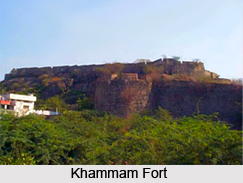 History of Khammam District in Telangana has followed a long line of development. The present name of "Khammam District" is said to have been derived from the name of a temple "Narsimhadri". It was later renamed as "Stamba Sikhari" and then it was termed as `Stambadhri`. There is a vertical rock under the temple known as `Kamba`. The name of the town seems to have been derived from the name of this hill of Kamba, and the name of the district was thus made Khammam.
History of Khammam District in Telangana has followed a long line of development. The present name of "Khammam District" is said to have been derived from the name of a temple "Narsimhadri". It was later renamed as "Stamba Sikhari" and then it was termed as `Stambadhri`. There is a vertical rock under the temple known as `Kamba`. The name of the town seems to have been derived from the name of this hill of Kamba, and the name of the district was thus made Khammam.
Khammam town was initially the seat of Taluk administration of the larger Warangal District till the 1st of October, 1953. Five taluks of the Warangal district, viz, Khammam, Madhira, Yellandu, Burgampadu and Paloncha (Now Kothagudem) were carved out and a new district, Khammam, with Khammam as district headquarters. In 1959, the Bhadrachalam Revenue Division, consisting of Bhadrachalam and Nuguru Venkatapuram Taluks of East Godavari district, which were on the other side of the Godavari River, were merged into Khammam on grounds of geographical contiguity and administrative viability.
In 1973 a new taluk with Sathupalli as headquarters was formed carving out from Madhira and Kothagudem taluks. In the year 1976 four new taluks were formed viz., Tirumalayapalem, Sudimalla, Aswaraopeta and Manuguru by bifurcating Khammam, Yellandu, Kothagudem and Burgampadu taluks respectively. In the year 1985, following the introduction of the Mandal system the district has been divided into 46 mandals, in four Revenue Divisions - Khammam, Kothagudem, Paloncha and Bhadrachalam.
A number of famous personalities from the district have been part of the freedom movement down the ages. Some of them are Jamalapuram Kesava Rao, Kurapati Venkata Raju, Vattikonda Ramakotaiah, Heeralal Moriya, Kolipaka Kishan Rao, Gella Keshava Rao, Pullabhotla Venkateswarlu, Nedumuri Jagannatha Rao, Pabbaraju Ranga Rao, and Sarvadevabhatla Ramadham among others.



















